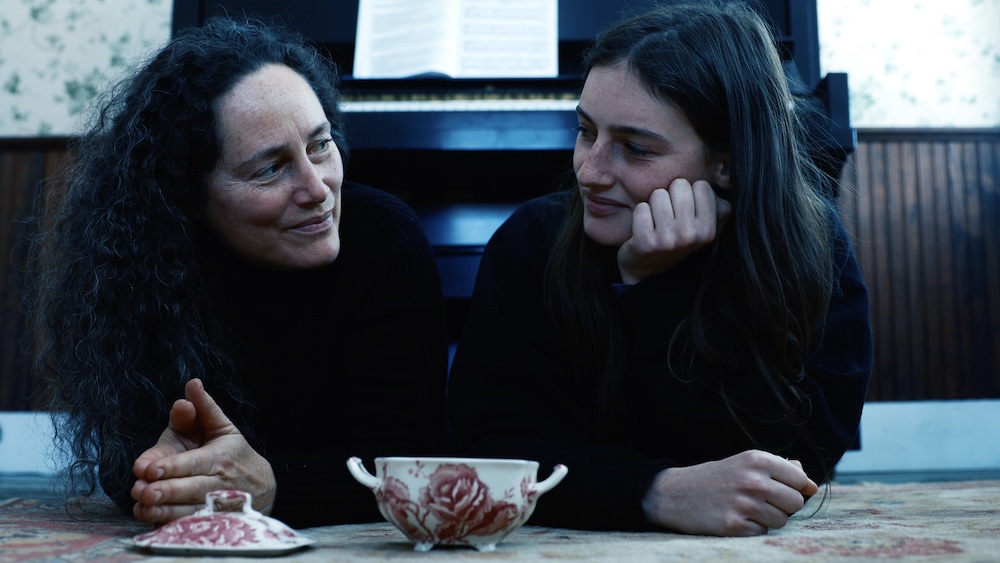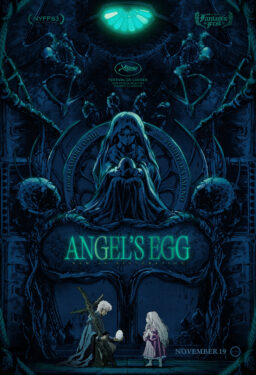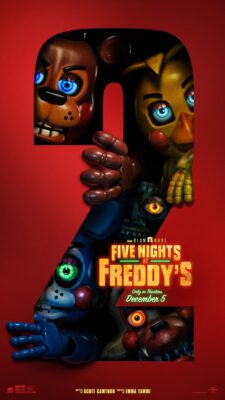The latest conjuring from the DIY filmmaking group known as the Adams family is “Hellbender,” a punk rock horror story of a self-isolated mother (Toby Poser) and daughter (Zelda Adams) who rock out together, and share a long-buried witchy legacy. The film is co-written and co-directed by Zelda Adams, her mother Toby Poser, and her father John Adams, and everyone shares other duties. Along with those duties, Zelda and John are the credited cinematographers, Toby did the costume design, and John did the editing and score. Zelda’s older sister Lulu also appears in the movie as someone that Izzy tries to befriend when breaking from her isolation.
Hidden inside “Hellbender” is the footage of a 20,000-mile, cross-country Adams family road trip, that started in their home state of New York, went up to Maine, and across to Washington. As the family notes, this is also how they made their first film, 2013’s “Rumblestrips,” when Zelda was six and Lulu was eleven. “Hellbender” is bound to make them even more of a household name among horror fans, coming after their previous Shudder hit, “The Deeper You Dig.”
RogerEbert.com spoke to the Adams family about the making of their film, their individual creative philosophies, what nature gives back to them, and more.
What fired you up when you were starting to conceive the story of “Hellbender”?
TOBY POSER: We had our band Hellbender, and that preceded “Hellbender” the movie. We started to make some music videos, and we were just exploring. We didn’t know what his “Hellbender” concept was. It just kind of fed itself to us, something very witchy and dark and crooked and gnarled and otherworldly came out.
JOHN ADAMS: We also learned a ton from our “Deeper You Dig” run, reviews and we love going to festivals because we get to talk to other filmmakers and audience members. One of the things that we did hear quite a bit is, “Oh, I really would have loved to have seen the mother daughter relationship developed more,” and we were like, “Hey! We can do that!” And they were right. It was so fun to watch these two on-screen together.

How does it become clear who takes on what filmmaking role as the production comes together? I’m curious how it works out on set.
TP: Well we, basically we sit around and we eat a lot of meals together. And we throw what we said spaghetti, invisible brain wads, and see what sticks. We have a lot of meals, we have a lot of rides in the car, it used to be a lot of driving Zelda to soccer practice, and we kind of, as the story whittles down to something that we want to shoot, the characters come into play too. We knew we wanted it to be a mother and daughter who had some universal truths that other mother-daughters could connect to, but through a strange supernatural lens. What’s it like being a hellbender, one step above the food chain, but in a human world? And let’s make them rock out.
ZELDA ADAMS: It’s interesting, I can’t actually remember a day where we’re not making a movie. Right when we finished “The Deeper You Dig,” we started pondering our next movie, and started making it as soon as possible. Because our filmmaking life and our family life are perfectly intertwined. We wake up, have breakfast, go out and shoot. And then come home and edit while we’re talking about other things. It’s so fun.
Do you guys have movie nights where you concentrate on what you need to watch for inspiration?
JA: Definitely, we love movie nights. And it’s basically never, “Hey, let’s research this,” it’s more like, Zelda will say, “You guys need to watch this movie.” Or we’ll see, “OK, and you need to see ‘One Flew Over the Cuckoo’s Nest.’” But there’s a lot of like, throwing around movies, and it’s really cool. The same thing that happens musically, which is Zelda will be like, “You need to listen to Courtney Barnett,” and it’s like, “OK, cool, but you need to listen to Bad Brains’ first album.” Because the stuff she loves is just from a different generation than the stuff that we maybe grew up. It’s cool how this intergenerational stuff is really weaving a fun rug.
Yeah, I think what’s really striking about your films is that you offer something people don’t have because of these generational differences. And it’s making your own way of making films.
JA: Yeah, it’s turning out like that. We didn’t set out on this journey, but also I think the architecture of how we make movies is at the root of your question. We know that Toby is a great writer, and so when we come up with an idea at the spaghetti dinner, it’s like, “Cool, Toby, could you now turn it into a beautiful little story circle?” And she does. People have found what they’re really powerful at in our little unit.
TP: And Zelda has an amazing eye, visually. And John is really great with conjuring up action, and we’ll try to figure out, “Why do we do that action?” And between the three of us, and when Lulu is around, she has great ideas, we just bring our own spice and see what we can cook with that.
Especially with the film’s experimental passages, involving a supernatural book, were those trickier to get right because they’re so instinctual?
JA: It’s a combination, originally we were making a video for a song called “Black Sky,” and we made a couple editing mistakes. Something happened in the editing bay that was completely by mistake. And we saw it and we were like, “Wow! How did we do that?” And we had to go figure out how we made that mistake, and then it really informed making “Hellbender.” Once we figured out how to make that super colorful, saturated strange mistake, how we could repeat that and how we could get better at it, that became really important to our storytelling, because we wanted their world to be hyper real.
And also what informed those book visions, and those dream visions, was the fact that we were living in an RV, driving around the country. Nature was just telling us when to film. We would be like in the Green Mountains, or the Pacific Northwest, and the storm would roll in, and we’d be like, “Oh my god, we need to film this now.” And luckily we’re just a unit of three, sometimes four. We can just set up a mic and a camera and we’re filming ten minutes.

What’s this RV trip? When was this? What?
ZA: So actually, this whole movie was shot during COVID. The only scene that wasn’t was the opening scene with all the women, that was like three days before the country shut down. And then, we kind of had this bigger story idea, we were going to shoot in my public school and there were going to be more characters. Maybe a romantic relationship! But then with COVID, we were like, “Yeah, that’s not going to happen!” And I think it’s a good thing that it’s not going to happen, we needed to get back to our small scale of crew and production, and just shoot what we know, shoot with our personal size. And I’m so happy we got a little slap in the face to do that. Because it really did make this movie feel more isolated, especially in a huge time of isolation.
JA: And we bought an RV because suddenly she didn’t have to go to school. Her school got canceled, and we were like, “You know what, let’s just get a trailer and drag ourselves around America and finish this movie. And let America tell us how it’s going to play out. And it was a very interesting time to live in a trailer, because we had a lot of things to ourselves.”
Were there more road trippy elements in the earlier cuts, documenting different parts of it?
ZA: You know, we had a lot of stuff that didn’t make it into the dream sequences that we really could have made one total psychedelic big film, because America is constantly throwing candy at you.
JA: Those dream sequences are filled with slices of America, from the West to the Pacific Northwest to the deserts of Arizona, to the lakes of Maine, to the fog of … those dream sequences are cut up so much that you don’t really ever say, “Oh, that’s Maine! That’s the Maine coast!” The fog of the Maine coast is mixed with a hot bath from Big Horn mountains. You don’t notice where all these things are coming from, but without a doubt, the nature of America was informing everything we were doing.
That explains why “America” was in your special thanks.
TP: We’ve already started working on another film, and I’ve already started compiling the credits because I don’t want to forget. And the first thing in the thanks I wrote: “Nature.” [laughs] Because she’s our Norma Desmond and CEO, dictating to us and asking for a close-up at the same time.
What do you feel that nature, like using your own backyard for “Hellbender,” gives you to as filmmakers?
ZA: Oh my god, nature and our backyard just brings us everything! It’s just waiting and asking to be filmed. It really gives us the best gifts, to be honest. We were going to shoot some walking footage, I think, but as we were walking across this forest we came across his huge deer carcass. And we were like, “Oh my god. Obviously we need to make a scene around this, are you kidding? We’d be the dumbest people alive if we didn’t.” And that’s one of my favorite scenes in the movie now, we didn’t even plan on it, we just came across this carcass and I think it’s beautiful that the world brings us that.
JA: And it’s also, nature is saying, “I’m going to literally throw you a bone. This is going to be the summation metaphor for your whole movie.” And it’s great. Nature does that all the time. We are just trying to keep up with her.
Are you guys vegetarian or vegan? The idea of a hellbender “eating an animal’s fear” reminds me of the philosophy of veganism.
TP: Yeah, the fear element. We were composing these plates that looked like they could be on the cover of Gourmet magazine, the thorns and the pine cones. I thought they looked pretty tasty. But it was the antithesis of what a hellbender would really like, and that’s actually my favorite scene in the movie when the mother feeds the worm. It’s nothing. The mother has gone from completely starving their hellbender bloody nature.
But onto the fear: historically, women, we think of the witch trials, women who were maligned. They were very powerful, and a lot of that was based in others’ fear. Well, why don’t we have the hellbenders—that’s just what they love to devour. You’re going to be afraid of us, then we’re going to devour your fear. We will end you because of your fear.
JA: And fear is what gave them power.
ZA: On the vegetarian and meat-eating front, we have a lot of conversations because we love talking about things when we’re not talking about filmmaking. Is it OK to be eating meat, is it not? And that kind of comes into the film a lot, like what is our nature versus what is our nurture? What is right and wrong and who determines what is right and wrong? John is a carnivore and Toby is a vegan.

Do you have personal creative philosophies? I almost want to say a mantra, but those are private. Is there something that drives the process or keeps you going day by day creatively?
TP: We love to be influenced by other people and other films and other artists. But I feel like it’s important for us to never follow the rules. So I think any inspiration we get, I always like to say, “Well, come in this ear but go out the other. So only a little bit sticks in my brain along the way.” I think there are so many wonderful people, it’s hard to do something original. And we just don’t want to follow too many rules.
JA: For me, the two ideas that drive me are, “Is it honest?” and “Is it fun?” If it’s not fun, I don’t want to do it.
ZA: I really think as a family, it’s kind of our motive to literally go out and do it. We don’t really get anywhere by talking it out, or having this huge structure of what we’re going to do. We just go out and do it, and that’s where we get the most done. Sometimes it doesn’t work, we screw up and we have to go and shoot it the next day, but that’s OK, we learned. And we wouldn’t have learned if we didn’t go out and do it.
To honor the idea of going out and finding a shot, I have to talk about my favorite shot in the movie, when you Zelda are perched on top of a light post as someone walks up a hill below you. How did you do that? Do you climb light posts?
ZA: I’m a hellbender! [laughs] That was so fun, that was actually in Washington. We had to edit that to make it look like I was on the light post. It was so fun, and then we dressed Toby up like an old woman, so we had her do couple walks, maybe a limp, and that’s one of our favorite shots in the movie. And it really hints at what Izzy is up to, if people are paying attention.
JA: Zelda actually came up with that shot. We were trying to devise a way that the hellbender could be in the trees, somehow perched like a bird of prey. We kept looking for something, and Zelda found a way to put the camera down, almost in the middle of town, and you can’t tell.
ZA: It’s actually a little of an embarrassing story. I was wandering around alone, making TikToks because I was bored. And then I set my phone up, like “This is aesthetic, this looks good.” And then I came home and showed them and it looks perfectly for the movie, the shot.
TP: And what was really cool, below where we ended up shooting her on this big sort of pedestal, this old military camp among the Puget Sound, we saw orchids. Sort of below where we shot her, there was a pile of orchids. Whenever I see that scene, it just reminds me what a fun beautiful experience it was making “Hellbender.”
JA: And a fun detail for us, as a family—at the very bottom of that shot, is the Cascade mountains, and Mt. Rainier is in the distance, in the sunset. And it’s like, nobody would ever see that, but we can always look at it and be like, “Oh, what a day. What a day.”
“Hellbender” is now playing on Shudder.












